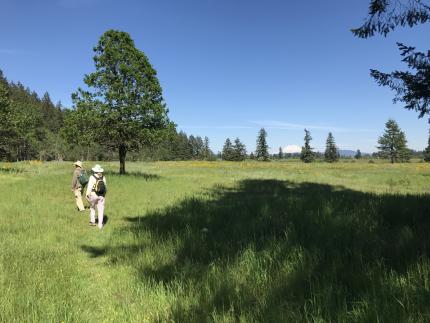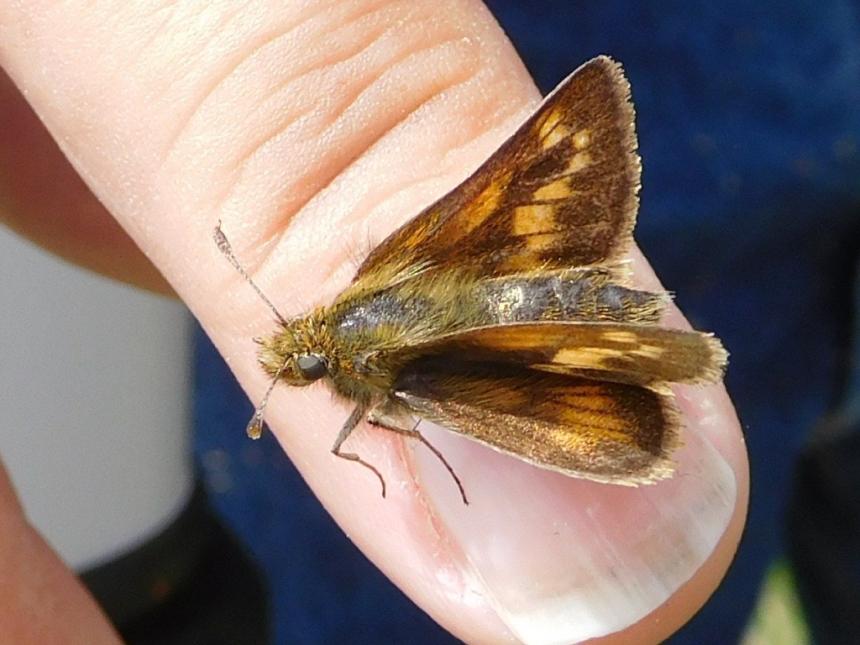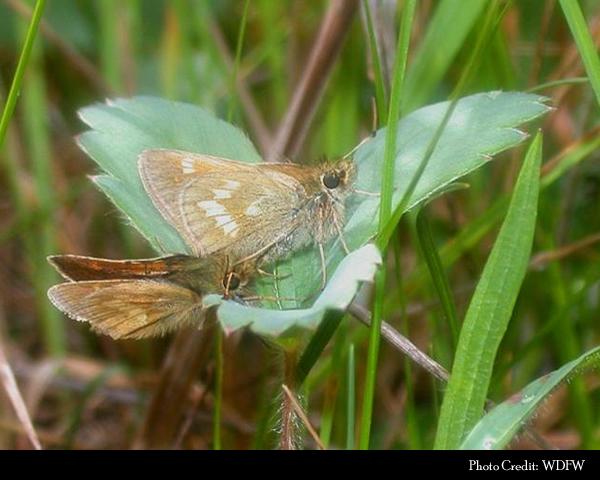Moderate-
High
The mardon skipper population size is low and declining. This skipper is currently found at only four, small, geographically disjunct areas in Washington, Oregon, and California. It is one of five butterflies in the Skipper Family recognized as "Species of Greatest Conservation Need" throughout their ranges due to the small number of isolated populations, specialized and restricted habitat, and known threats to their habitat. Research is needed to better understand threat factors and specific habitat requirements, such as vegetation structure, food plant size and density, and other key habitat features.
Description and Range
Physical description
The mardon skipper is a small, tawny-orange butterfly with a stout, hairy body..
Ecology and life history
In south Puget Sound grasslands, mardon skippers use open, grass dominated habitat with abundant Roemer’s Fescue interspersed with early blue violet and select early blue violet and common vetch as nectar sources. Adult mardon skippers select for short, open-structured, native fescue grasslands, which provide access to nectar and oviposition plants and a requisite thermal environment. Mardon skippers on two south Sound prairies oviposited (laid eggs) on Roemer’s fescue, and females selected for small, mostly green fescue plants, in sparse, short-statured, and open-structured vegetation.
In the southeastern Cascade Mountains, mardon skippers are found in meadows in an otherwise forested landscape; a variety of grasses and sedges are used for egg-laying (and larval hosts) and females select for large, well developed plants. The historical and ongoing loss of montane meadow habitat is well-documented.
These skippers complete a single life cycle annually (univoltine).They are sedentary butterflies and do not migrate; instead, the species inhabits sites year-round (as egg, larva, pupa and adult), typically moving within only a few hundred meters of their natal locations.

Male skippers seek mates by perching on low vegetation and then darting out to inspect passing butterflies. Males that detect females commence courtship behavior; when males detect another male they engage in a territory defense behavior of tight, upward spiraling flight.
Females search for egg-laying sites by slowly flying and hovering just above hostplant vegetation and then depositing single eggs.
Skipper larvae conceal themselves in silken shelters and primarily feed at night. Hesperiinae larvae create shelters formed by webbing their hostplant grass blades together, and their prepupal larvae construct strong silken shelters in hostplant grasses in which pupation occurs. These species overwinter as larvae.
Adults emerge from their chrysalids (pupae) during May through June. Males begin emergence first, followed by females; late-season individuals are primarily or solely females. Weather influences butterfly emergence and the flight period duration, with wet or cold conditions delaying emergence.
Both males and females feed by using their long proboscis to sip floral nectar.
Geographic range
Mardon skippers primarily occur in a few small, isolated populations. Overall, their population is highly disjunct. Their range includes South Puget Sound and southeast Cascades in Washington, southwestern Oregon, and northwest California.
In Washington, the mardon skipper inhabits glacial outwash prairies in the south Puget Sound region, and montane meadows 1800 to 5500 feet in elevation in the southeastern Cascade Mountain Range. Glacial outwash prairies in western Washington have been reduced to less than three percent of historical cover.
For a map of range-wide distribution and conservation status of the mardon skipper, check out NatureServe Explorer.
Climate vulnerability
Sensitivity to climate change
Moderate-
High
Climate sensitivity of this species is influenced by increased temperature, changes in precipitation patterns, early snowmelt, reduced snowpack, and increased wildfire. Population numbers vary annually in response to variable weather because Mardon skippers exhibit physiological and indirect (i.e., habitat) sensitivity to temperature and precipitation. Temperature influences butterfly behavior (e.g., mating, foraging, egg-laying time), adult life span, and larval development. Cool, wet spring conditions limit adult activity and therefore fecundity. Warming temperature may also affect phenological timing between Mardon skipper and key plant species (host and nectar plants) possibly causing low availability of nectar resources and pre-mature desiccation of larval forage, leading to reduced fitness or starvation of adults or larvae. A majority of Mardon skipper populations in WA are located in higher elevation sites, where warming temperatures lead to reduced snowpack/earlier snowmelt creating highly exposed, novel conditions for overwintering likely increasing mortality, and contribute to habitat degradation by hastening conifer encroachment in the butterfly's open, grassland habitat. Mardon skippers are also vulnerable to fire. Fire helps maintain open grassland habitat used by the Mardon skipper by preventing conifer encroachment, but Mardon skippers are highly sedentary and unable to escape fire, therefore fire can cause direct mortality of all life stages. Increasing fire frequencies may expand overall habitat area available for Mardon skipper, but could contribute to population extirpation if fire occurs in current habitat areas.
Exposure to climate change
Moderate-
High
- Increased temperatures
- Changes in precipitation
- Altered fire regimes
- Increased frequency of temperature and precipitation extremes
- Reduced snowpack
- Earlier snowmelt
Conservation

Conservation Threats and Actions Needed
- Invasive and other problematic species
- Threat: Invasive plants, those currently here, and many yet to come in the future, out-compete native grassland species, and otherwise make habitat unsuitable for the Mardon skipper.
- Actions Needed: Using herbicide, fire, and mechanical methods to restore native prairie; planting/seeding native prairie species.
- Threat: Forest encroachment due to long-term fire suppression has reduced amount and quality of habitat. Hostplant is a grass, and species utilizes open meadows.
- Action Needed: Remove invading trees and shrubs.
- Resource information collection needs
- Threat: Knowledge of current distribution and site status in the southern Cascade Mountains is incomplete.
- Action Needed: Conduct surveys to determine current status and distribution in the Washington southern Cascades.
- Threat: High likelihood south Sound and Cascades populations are distinct species.
- Action Needed: Genetic study to evaluate difference between south Puget Sound and Cascades populations.
- Climate change and severe weather
- Threat: Species is vulnerable in south Puget Sound to cool, wet spring weather; in the Cascades, to warm winters with low snowpack.
- Action Needed: Evaluate landscape and develop plan to increase habitat area and habitat heterogeneity in currently occupied sites and within occupied landscapes.
See the Climate vulnerability section for more information about the threats posed by climate change to this species.
Resources
References
Beyer, L. and C. Schultz. 2010. Oviposition selection by a rare grass skipper Polites mardon in montane habitats: Advancing ecological understanding to develop conservation strategies. Biological Conservation 143:862-872.
Crawford, R. and H. Hall. 1997. Changes in the south Puget Sound prairie landscape. Pp 11-15 in P. Dunn and K. Ewing (eds.) Ecology and Conservation of the south Puget Sound Prairie Landscape. The Nature Conservancy, Seattle, Washington. 289pp.
Hays, D., A. Potter, C. Thompson, and P. Dunn. 2000. Critical habitat components for four rare south Puget Sound butterflies. Final report to The Nature Conservancy. Washington Department of Fish and Wildlife. Olympia.
Henry, E. and C. Shultz. 2012. A first step towards successful conservation: understanding local oviposition site selection of an imperiled butterfly, mardon skipper. J. Insect Conserv. DOI 10.1007/s10841-012-9496-x.
James, D. and D. Nunnallee. 2011. Life Histories of Cascadia Butterflies. Oregon State University Press, Corvallis. 447pp.
Pyle, R. 2002. The Butterflies of Cascadia. Seattle Audubon Society. Seattle, WA. 420 pp.
Pyle, R. 1989. Washington butterfly conservation status report and plan. Washington Department of Fish and Wildlife, Olympia. 216pp.
Schultz, C., E. Henry, A. Carleton, T. Hicks, R. Thomas, A. Potter, M. Collins, M. Linders, C. Fimbel, S. Black, H. Anderson, G. Diehl, S. Hamman, R. Gilbert, J. Foster, D. Hays, D. Wilderman, R. Davenport, E. Steel, N. Page, P. Lilley, J. Heron, N. Kroeker, C. Webb, and B. Reader. 2011. Conservation of prairie-oak butterflies in Oregon, Washington, and British Columbia. Northwest Science 85: 361–388.
Takaoka, S., and F. Swanson. 2008. Change in extent of meadows and shrub fields in the central western Cascade Range, Oregon. The Professional Geographer 60:527-540.
Thompson, J. 2007. Mountain meadows—here today, gone tomorrow? Meadow science and restoration. Science Findings Issue 94. PNW Research Station, Portland, OR.
WDFW publications
PHS Program
Status reports
- Period Status Review for the Mardon Skipper (2023)
- Washington State Status Report for the Mardon Skipper (1999)

